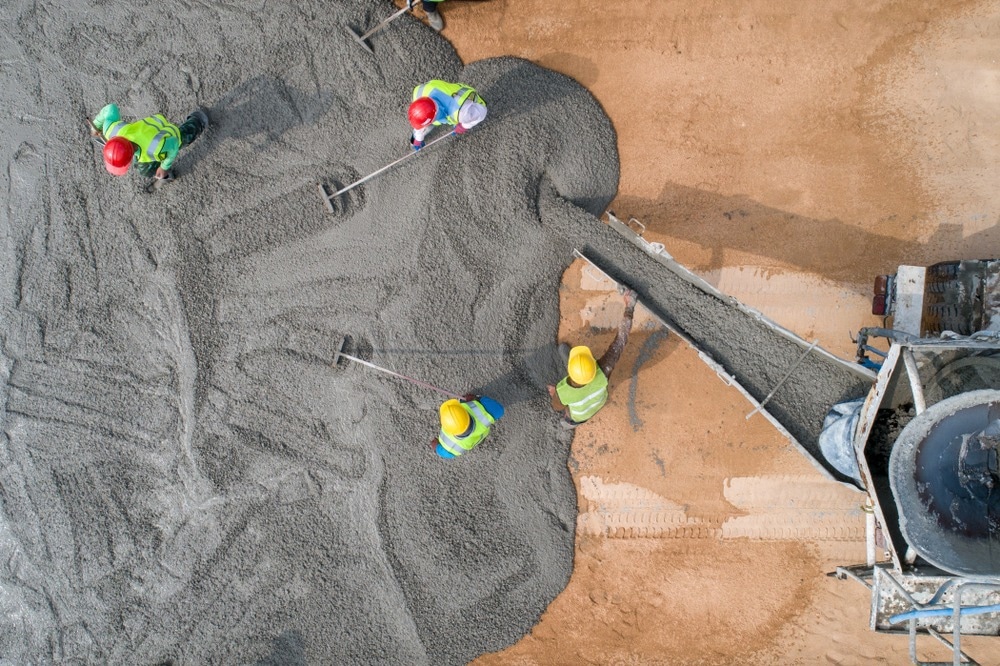A paper published in Materials Today: Proceedings examined the mixing of concrete with magnesia (MgO) nanoparticles from the perspective of sustainability.

Study: Investigating the reliability of nano-concrete at different content of a nano-filler. Image Credit: Bannafarsai_Stock/Shutterstock.com
Concrete – Can it Keep Up with Advanced Constructions?
Concrete is a mixture of coarse and fine aggregates held together using a cement paste that hardens with time.
The plentiful supplies, high flexibility, and well-established production procedures make concrete the most ubiquitous construction material on the plant
Many different types of mortars may be constructed by mixing the constituents in the appropriate amounts. Despite the development of modern cementitious composites, conventional mortar production techniques are no longer suitable to fulfill the needs of advanced multipurpose structures.
Advanced structures present tougher challenges for concrete. Therefore, there is a pressing need for practical and advanced concrete solutions.
The Role of Nanomaterials in Improving Durability of Cementitious Materials
Durability is one of the most critical and challenging issues faced by the construction industry.
The development of nanomaterials has fueled the efforts to use more environmentally friendly materials. Nanomaterials are characterized by their large outer surface areas and better strength and tribological properties as compared to conventional materials.
Many ceramic compounds have significant cementitious reactions with oxides of calcium, which leads to the generation of additional silicates. This ultimately helps improve the structural characteristics and durability of cementitious materials.
Fiber-like materials improve the tensile properties of mortar by bridging cracks and preventing further crack growth thanks to their needle-like operation.
The Issue of Spall Liners
Recently, cementitious supplements have been extensively explored for producing concrete slabs.
These additives increase interracial transit areas among cement and agglomerates and assist in generating dense crystallites, indicated by the enhanced physical properties.
Nonetheless, when exposed to extreme temperatures, these closely packed structures respond unpredictably, resulting in spall liners.
Spall liners occur because of inadequate permeability for pressure distribution, thermal fluctuations, or the buildup of thermal gradients.
The fibers are thermodynamically unstable; therefore, they combine at about 300 degrees Celsius and generate pockets of air. The presence of these air pockets adversely affects the lifespan of the composite.
Can Nanoparticles Reinforce Concrete?
Concrete mixes are susceptible to fractures and lack desirable qualities as they are generally semi-brittle. Incorporating nanomaterials in concrete mixtures is being hailed as the solution to these problems.
Ceramic nanoparticles, carbonaceous nanoparticles, and metal nanoparticles have been found to improve the structural and physical properties as well as the lifespan of concrete mixes at ambient temperatures.
The corrosive atmosphere of cementitious composites is caused by the oxidative activity produced during the hydration process and the depositing of extra C-S-H inside the porous architecture. This ultimately improves the mechanical properties of cementitious materials.
The nanomaterials appear to have a strong filler effect, producing a significant nanoscale binding and precipitation implication, which ultimately promotes an accelerated hydration process.
Due to the transition from an inactive to a highly active corrosive phase, countless microscopic cracks begin to grow larger. To overcome this problem, it is critical to include nanowires that employ the nano-level stiffness of C-S-H hydrogel to limit the propagation of nanoscale fractures.
Findings of the Study
The effect of MgO nanoparticle content on the durability properties of conventional concrete was investigated in this research using 6%, 4%, and 2% mass fractions of MgO nanoparticles.
When the dosage was kept within a small range, MgO nanoparticles greatly increased the fracture resistance, sorptivity, and porosity of cementitious composites.
The fracture transmission, sorptivity, and moisture permeability of concrete were all substantially lowered by increasing the mass fraction of MgO nanoparticles.
However, if the mass fraction of MgO nanoparticles in cementitious composites surpassed a specific limit, the mortar would become less dependable.
When 4% mass fraction of MgO nanoparticles was added to a standard cement mortar, it enhanced moisture permeability depth by about 45%. Furthermore, adding 3% mass fraction of MgO nanoparticles to the cementitious mixture reduced sorptivity by about 30% and fracture length per unit area by about 83%.
The ideal MgO nanoparticle dosage was recommended to be 4% to positively affect the fracture, permeability, and sorptivity parameters of the cementitious composite.
Reference
Neeraja, V. S., Mishra, V., Ganapathy, C. P., Sunagar, P., Kumar, D. P., & Parida, L. (2022). Investigating the reliability of nano-concrete at different content of a nano-filler. Materials Today: Proceedings. Available at: https://www.sciencedirect.com/science/article/pii/S2214785322053512?via%3Dihub
Disclaimer: The views expressed here are those of the author expressed in their private capacity and do not necessarily represent the views of AZoM.com Limited T/A AZoNetwork the owner and operator of this website. This disclaimer forms part of the Terms and conditions of use of this website.